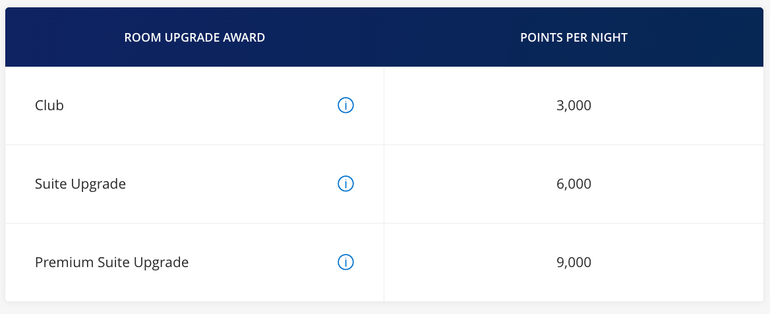The Complete Guide to World of Hyatt: Points, Status & Strategy
Hyatt offers the highest-value hotel rewards of any program NerdWallet analyzed. Let's hope one of its properties is in your destination.

Many or all of the products on this page are from partners who compensate us when you click to or take an action on their website, but this does not influence our evaluations or ratings. Our opinions are our own.
World of Hyatt consistently ranks as one of the best hotel loyalty programs for its high point value and elite benefits. The drawback? Its smaller network of 1,150+ properties limits where you can use those valuable points. After analyzing earning rates, redemption values and elite status requirements, here's everything you need to know to maximize this premium program.
Why Hyatt points matter
Based on our most recent analysis of hotel loyalty programs, World of Hyatt points hold the most value among major hotel rewards programs. When using points for free hotel nights, each World of Hyatt point is worth 1.8 cents. Here's how Hyatt points compare to competitors:
World of Hyatt: 1.8 cents per point (NerdWallet valuation)
Marriott Bonvoy: 0.8 cent cent per point.
Hilton Honors: 0.4 cent cents per point.
IHG One Rewards: 0.6 cent per point.
The advantage: Hyatt points are worth 2-4x more than competitors, making strategic earning and redemption crucial for maximizing value.
The limitation: Hyatt's smaller footprint means fewer opportunities to earn and redeem Hyatt points compared to Marriott or Hilton.
Hyatt also allows members to earn additional free nights by earning status, or by holding the World of Hyatt Credit Card.
» Learn more: Find the best hotel credit card for you

The lobby of the Hyatt House Sacramento/Midtown in California. Photo courtesy of Hyatt.
World of Hyatt brands: understanding your options
The World of Hyatt loyalty program includes a range of hotels for style and price. The most popular Hyatt brands include:

Hyatt Place Hangzhou International Airport. Photo courtesy of Hyatt.
Budget-friendly brands:
Hyatt Place: Upscale with free breakfast for members.
Hyatt House: Extended-stay suites with kitchens.
Premium brands:
Hyatt Regency: Business-focused upper-upscale.
Hyatt Centric: Boutique lifestyle hotels.
Andaz: Design-forward luxury.
Luxury brands:
Grand Hyatt: Full-service luxury properties.
Park Hyatt: Ultra-luxury residential-style hotels.
All-Inclusive resorts:
Hyatt Zilara/Ziva: Adults-only and family-friendly resorts.
Secrets/Dreams/Breathless: Acquired brands in Caribbean/Mexico.
How much are my World of Hyatt points are worth?
NerdWallet values World of Hyatt points at 1.8 cents apiece. To determine the value of reward points, we compared cash prices and reward redemptions for hotel stays across several destinations and dates. We divided the cost in cash by the cost in points to determine a “cent per point” value for each hotel night, then found the 75th percentile of this value across several searches.
To determine the value of your points for specific bookings, divide the cash value (minus any fees associated with the reward booking) by the number of points required. Use this Hyatt points to dollar calculator to see the value of your stash.
So if a hotel room would cost either $100, or 15,000 points + $10 in resort fees, the math would be as follows:
($100 – $10) / 15,000 = 0.006, or 0.6 cent per point.
The value of Hyatt points over time
The bad news: Hyatt points have dropped in value since recent years. The good news: Hyatt is still one of the most valuable points programs out there.
World of Hyatt's elite status program
World of Hyatt offers four membership levels of Hyatt elite status: Member, Discoverist, Explorist and Globalist.
The most common way to earn Hyatt elite status is through staying frequently at Hyatt hotels. But you can also earn automatic elite status through holding a Hyatt credit card. Here's how to earn Hyatt elite status, and what you get for holding it:
Hyatt Member
How to earn Member status: All members start as World of Hyatt members. Simply sign up and hand over your email.
Points earned: Members earn 5 base points for every $1 spent on qualifying stays, dining and spa experiences charged at the hotel. Members earn 10 points for every $1 spent on FIND experiences.
Other benefits:
Free standard internet access at participating hotels.
Free breakfast at Hyatt Place for stays booked through Hyatt.com. may also qualify for free breakfast during their stay.
Member Rate discounts at participating hotels and resorts for reservations made either online or through the dedicated reservations telephone number.
Resort fees waived when points are used for an award night.

The Kitchen at Hyatt Place Huangshan Train Station in China. Photo courtesy of Hyatt.
Hyatt Discoverist
How to earn Discoverist status: Stay 10 qualifying nights, earn 25,000 base points, host three qualifying meetings or events, or open the World of Hyatt Credit Card.
Points earned: Members earn 5 base points for every $1 spent on qualifying stays, dining and spa experiences charged at the hotel. Members earn 10 points for every $1 spent on FIND experiences. Plus, earn 10% bonus points when you choose points as your reward.
Other benefits:
All of the above member benefits included in the lower tiers, as well as:
Premium internet.
A dedicated check-in line.
Late checkout (upon request, and when available) of 2 p.m. at participating locations.
No upgrades, though you'll receive the preferred room within the room type booked upon arrival.

A guest room at Hyatt House Tokyo Shibuya. Photo courtesy of Hyatt.
Hyatt Explorist
How to earn Explorist status: Stay 30 qualifying nights, earn 50,000 base points, or host 10 qualifying meetings or events.
Points earned: Members earn 5 base points for every $1 spent on qualifying stays, dining and spa experiences charged at the hotel. Members earn 10 points for every $1 spent on FIND experiences. Plus, earn 20% bonus points when you choose points as your reward.
Other benefits:
All of the above member benefits included in the lower tiers, as well as:
An upgrade to the best room available at check-in (excluding suites), when available.
Four Club lounge passes on eligible rates or when redeeming points for free night awards.
Milestone award: Four Club lounge passes access awards and free night award at Category 1-4 properties.
Ability to request room reservations as soon as 72 hours ahead of your stay, although blackout dates apply.

At the club lounge inside the Hyatt Regency Orlando, fill up on coffee, pastries, yogurt and fresh foods before a day at the local theme parks — or have a glass of wine at the lounge upon return. Image courtesy of Hyatt.
Hyatt Globalist
How to earn Hyatt Globalist status: Stay 60 qualifying nights, earn 100,000 base points, or host 20 qualifying meetings or events.
Points earned: Members earn 5 base points for every $1 spent on qualifying stays, dining and spa experiences charged at the hotel. Members earn 10 points for every $1 spent on FIND experiences. Plus, earn 30% bonus points when you choose points as your reward.
Other benefits:
All of the above member benefits included in the lower tiers, as well as:
An upgrade to the best available room at check-in, including standard suites.
Late checkout (upon request, and when available) of 4 p.m. at participating locations.
Guaranteed availability 48 hours ahead of the stay.
Access to the hotel club lounge with every stay.
Complimentary parking at participating hotels and resorts.
Priority access to available rooms when checking in early.
Club access or breakfast.
When booking an eligible award for someone else, those guests will receive some elite benefits through the hotel’s Guest of Honor program.
Additional Milestone benefits: Four Suite upgrade awards, 5,000 points or a $100 Hyatt gift card or 10,000 points savings on a FIND experience, free night award at category 1-7 hotels and access to My Hyatt Concierge.
» Learn more: Should you pursue Hyatt elite status this year?

The lobby of Dream Flora Resort & Spa in the Dominican Republic. Photo courtesy of Hyatt.
Hyatt Lifetime Globalist status
Hyatt Lifetime Globalist status is only available after earning 1 million base World of Hyatt points. This designation grants all the benefits of Globalist every year, including one free night award up to Category 7 and four suite upgrade awards every March.
In order to qualify for lifetime status, all points must be earned in the same account. Only base points earned from eligible room rates, eligible incidental charges and eligible non-stay charges count toward lifetime status. Points earned from elite status bonuses, points earned from a Hyatt-branded credit card, or points transferred from other programs don’t count.
And if a member’s account is canceled for any reason (including inactivity), any forfeited lifetime points can’t be applied to another account.

The NUMU Boutique Hotel rooftop pool in Baja California Sur, Mexico. Photo courtesy of Hyatt.
Earning Hyatt points through hotel stays
Earn World of Hyatt points through Hyatt hotel stays, spending money with Hyatt’s travel partners, or through spending on the World of Hyatt Credit Card or the World of Hyatt Business Credit Card.
Earn World of Hyatt points at hotels
All World of Hyatt members earn 5 base points for every eligible $1 spent on qualifying stays, dining and spa experiences.
Elite members earn bonus points on top of base points. The bonus is based on status: Discoverists receive 10% bonus points, Explorists receive 20% bonus points and Globalists receive 30% bonus points.
On a qualifying stay of $100, here’s how many points members could expect to receive:
World of Hyatt members: 500 base points.
Discoverist elite: 500 base points and 50 bonus points.
Explorist elite: 500 base points and 100 bonus points.
Globalist elite: 500 base points and 150 bonus points.
While base points count toward elite and lifetime status, bonus points do not. In the example above, a Globalist member would earn 500 points toward elite and lifetime status, but the extra 150 bonus points apply only toward future awards.
Can you earn Hyatt points when booking Hyatt hotels through third parties?
Typically no. Hotel stays booked at online travel agencies (i.e. Priceline, Expedia) don't earn points or benefits.
Some exceptions include travel agencies such as American Express Fine Hotels and Resorts, which do allow you to earn elite benefits and points.
FIND Experiences can earn World of Hyatt Points
World of Hyatt members can also earn elite-qualifying points by booking FIND experiences directly on the World of Hyatt website. FIND is a collection of experiences offered through luxury partners that are not necessarily available at the hotel or through an online travel agency.
Examples of FIND Experiences include:
Las Vegas: A private feeding and yoga session with baby goats at Goat Yoga.
New York: A private bonsai class with artist Julian Velasco.
Chicago: An Amalfi pasta making class and dinner experience with chef Aram Reed.
Boston: Group rowing outing in Boston Harbor.
Miami: Melt and pour soap-making and natural beauty workshop.
Note that none of these are cheap. To book an event, create a separate account on the FIND website. Each experience earns 10 base World of Hyatt points per eligible $1 spent, which applies toward elite and lifetime stays.
Credit cards that earn World of Hyatt points
There are two ways to get Hyatt points from credit cards: a Hyatt co-branded credit card, or a card that earns Chase Ultimate Rewards® points (which you can transfer to Hyatt.
Hyatt credit cards
Hyatt has two credit cards: the World of Hyatt Credit Card and the World of Hyatt Business Credit Card.
on Chase's website
on Chase's website
$95.
$199.
Earn up to 60,000 Bonus Points. Earn 30,000 Bonus Points after you spend $3,000 on purchases in your first 3 months from account opening. Plus, up to 30,000 More Bonus Points by earning 2 Bonus Points total per $1 spent in the first 6 months from account opening on purchases that normally earn 1 Bonus Point, on up to $15,000 spent.
60,000 Bonus Points after you spend $5,000 on purchases in your first 3 months from account opening.
• 4 points per $1 at Hyatt hotels and resorts.
• 2 points per $1 on dining, airline tickets purchased directly from the airline, gym memberships, and local transit and commuting.
• 1 point per $1 on all other eligible purchases.
• 4 points per $1 at Hyatt hotels and resorts.
• 2 points per $1 in your top three spend categories each quarter.
• 2 points per $1 on fitness club and gym memberships.
• 1 point per $1 on all other eligible purchases.
• Earn one free night on each cardmember anniversary to redeem at any Category 1-4 World of Hyatt property.
• World of Hyatt Discoverist status.
• Earn five elite night credits when you get the card, and two additional elite night credits for every $5,000 spent.
• Earn up to a $100 Hyatt statement credit on your cardmember anniversary.
• World of Hyatt Discoverist status.
• Earn a rebate of 10% of points (up to 200,000 points) redeemed after reaching $50,000 in annual spend.
• Earn five elite night credits for every $10,000 spent.
Credit cards that earn Chase Ultimate Rewards® points
Credit cards that earn Chase Ultimate Rewards® points, including the Chase Sapphire Preferred® Card, Chase Sapphire Reserve® and the Ink Business Preferred® Credit Card allow you to transfer those points to Hyatt. Points transfer at a 1:1 ratio and must be transferred in increments of 1,000 points.
$795.
$95.
$95.
Earn 125,000 bonus points after you spend $6,000 on purchases in the first 3 months from account opening.
Earn 75,000 bonus points after you spend $5,000 on purchases in the first 3 months from account opening.
Earn 90,000 bonus points after you spend $8,000 on purchases in the first 3 months from account opening.
» Learn more: Chase Ultimate Rewards: How the program works
Other ways to earn World of Hyatt points
Some current ways to earn additional World of Hyatt points:
Earn 500 bonus points for Avis car rentals: World of Hyatt members not only get up to 25% off base rates for each qualifying car rental through participating Avis locations, but they can also earn 500 World of Hyatt points per rental. To receive the points for every car rental, book your Avis reservation with Avis Worldwide Discount number K817700 on Avis.com. Be sure to provide your World of Hyatt number during your reservation and at the time of rental — otherwise, you may not earn the points.
Purchase Hyatt points: If you’re short on World of Hyatt points, it’s possible to purchase bonus points to get you closer to your next award or keep your account alive. You can purchase bonus points in 1,000-point increments for $24 each, up to 55,000 per transaction. While purchased bonus points don’t count toward status, they are a qualifying activity that will keep a dormant account alive. We generally don’t recommend purchasing points as a habit, and buying points at 2.4 cents each is above our estimated average value per point when using them for hotel nights.
» Learn more: The complete guide to earning Hyatt points
How to redeem Hyatt points
Best use of Hyatt points: free hotel nights
Award categories range from Category 1 to Category 8, with prices for a standard room award ranging from 5,000 points per night to 40,000 points per night. If you’re able to book an off-peak rate that’s even better.

Hyatt’s award chart also includes rates for club rooms, standard suites and premium suites, which you can browse here. When using your points for hotel night awards, we estimate your points are worth 1.8 cents each, which is the highest overall return for any rewards program we surveyed. Using your points for hotel awards is one of the best returns you can get anywhere in the industry.
» Learn more: Amazing suites you can book at Hyatt hotels with points
Use Hyatt points for Hyatt Points + Cash awards
Short on points? Redeem them for a Points + Cash award, which allow you to hand over some points and pay the rest in cash. This can be a good way to spend a remaining points balance that you don't want to otherwise sit on.
To determine if a Points + Cash award is a good value for your stay, compare the standard room rate with the value of the points you would use. If your points and cash equivalent is less than the cost of the standard rate, then it is a good deal.
Use Hyatt points for room upgrades on paid nights
You can also use points to upgrade your hotel room experience — which can make for a swell use of points.

Upgrades to the Regency Club/Grand Club level cost just 3,000 points per night. That's less than $100 based on NerdWallet's valuations of a Hyatt point.
But considering hotels tend to charge much more than $100 to upgrade to a club level, this makes for one of the best uses of Hyatt points. For example, the Regency Club at the Hyatt Regency San Francisco charges guests $125 per night if they want to upgrade their experience to include Regency Club access. (For what it's worth, even $125 can be worth it for some travelers given the luxury experience and high-quality, complimentary food available inside.)

Views from the rotating Hyatt Regency Club. (Photo by Sally French)
Note that upgrades to suites can cost much more, spanning between 6,000 and 9,000 points per night. If you have a long stay ahead of you, upgrading with points can cost the same as a standard room award. Unless it’s a special occasion, or you have no other use of your points, this might not be the best use of points.
Use Hyatt points toward spa and dining credits
Points can be used to pay for in-room movies, parking, transportation and other incidentals or hotel add-ons like meals or spa services by exchanging them for account credits.
However, this is a bad use pf points. Because points exchange at a rate of 0.5 cent per point, you would lose significant value by using points this way.
Use Hyatt points at all-inclusive hotels
Hyatt's all-inclusive brands include Hyatt Zilara, Hyatt Ziva, Zoëtry Wellness & Spa Resorts, Secrets Resorts & Spas, Breathless Resorts & Spas, Dreams Resorts & Spas, Vivid Hotels & Resorts, Alua Hotels & Resorts and Sunscape Resorts & Spas. Although they may be expensive, all-inclusive resort stays come with most activities and meals included. See how many points you need to book at those all-inclusives.
Points can also be used at Miraval resorts, for both award nights and Points + Cash awards. Awards at all Miraval resorts are:

Each award night at a Miraval resort includes a $175 resort credit per person, on top of gourmet food, snacks, drinks and wellness activities.
Use World of Hyatt points to book travel with Hyatt transfer partners
If you don't plan on staying at a Hyatt hotel anytime soon, you might find it more useful to convert those hotel points to Hyatt transfer partners, which include airline mileage programs or rental car companies.
FIND experiences: If you have a once-in-a-lifetime experience lined up but don’t want to pay cash for it, FIND experiences can be paid for with World of Hyatt points. The number of points you will need for an experience directly correlates with the price of the experience.
Exchanging for airline miles: World of Hyatt points can be transferred to 30 airline frequent flyer programs, including American AAdvantage, Delta SkyMiles, Southwest Rapid Rewards and United MileagePlus. Points convert at a ratio of 2.5 World of Hyatt points for every one frequent flyer mile, and a minimum of 5,000 points is required for each conversion request. Over 5,000 points, points must be transferred to miles in increments of 1,000 points.
Using points for car rentals: You can also exchange World of Hyatt points for Avis car rental certificates, to cut down on car rental fees. For 6,000 points, members can receive a certificate good for one day of an intermediate-size car rental with Avis.
These redemptions tend to devalue your points relative to booking Hyatt hotel rooms, but they can make sense if you don't intend to use your points on actual hotel stays anytime soon.
Best Hyatt point redemptions
Based on our 1.8 cents valuation of Hyatt points, here are the best uses of Hyatt points:
Book at Hyatt hotels: Most value comes from redeeming points at hotels, where they are worth an estimated 1.8 cents each. Value tends to increase when you stay at more upscale (e.g. Category 5-7) hotels.
Book weekends at tourist destinations, and weeknights in business districts: Save your points to cash in on the most expensive night of your stay, as rates are the same no matter what night of the week you book.
Use points to book Points + Cash awards: When Hyatt changed its Points + Cash awards from a flat fee and points to 50% of the required points and 50% of the standard room rate, many people called it a devaluation of points. However, in some situations, 50% of the standard room rate is less than the flat fee. Points + Cash options remain a good deal, especially if it can get you a discount on a great place to stay.
Stay at hotels with steep resort fees: No one, it seems, likes resort fees. While they typically range from $20-$30 a night, some get even steeper. The good news: World of Hyatt members won’t pay resort fees on free night awards, which could amount to significant savings just by opting to pay in points vs. cash.
Bad Hyatt redemption options
Transferring to airlines: When forced to exchange 5,000 points for 2,000 frequent flyer miles, you leave a little bit of value on the table. We value 5,000 World of Hyatt points at around $100 of value toward hotels, which you may not be able to recover when using them to book an airline award. While this can be useful in an emergency to get the final miles needed for a flight, this isn’t the best way to use your World of Hyatt points.
Using points toward Hyatt hotel credits: You can exchange points for purchases such as spa treatments, in-room movies and meals. But that drops your points exchange rate is just 0.5 cents each — significantly less than the average value of 1.8 cents per point. You’re better off charging your splurges to your hotel room and earning 5 base World of Hyatt points for each qualifying $1 to get a little closer to a free night or elite status.
How Hyatt compares to other major hotel programs
Hyatt came in third in NerdWallet’s rankings of best hotel this year.
But it won best hotel rewards program.
Hyatt points are high in value, which helped it score high in the rewards rate category. There’s just one subcategory where Hyatt ranks pretty terribly: fees.
Out of seven hotel brands analyzed, here's a closer look at how Hyatt competed:
Second place in rewards rate.
Third place in terms of elite status program.
Tied for worst fees.
How to maximize your rewards
You want a travel credit card that prioritizes what’s important to you. Here are some of the best travel credit cards of 2025:
Flexibility, point transfers and a large bonus: Chase Sapphire Preferred® Card
No annual fee: Wells Fargo Autograph® Card
Flat-rate travel rewards: Capital One Venture Rewards Credit Card
Bonus travel rewards and high-end perks: Chase Sapphire Reserve®
Luxury perks: American Express Platinum Card®
Business travelers: Ink Business Preferred® Credit Card
Table of Contents











